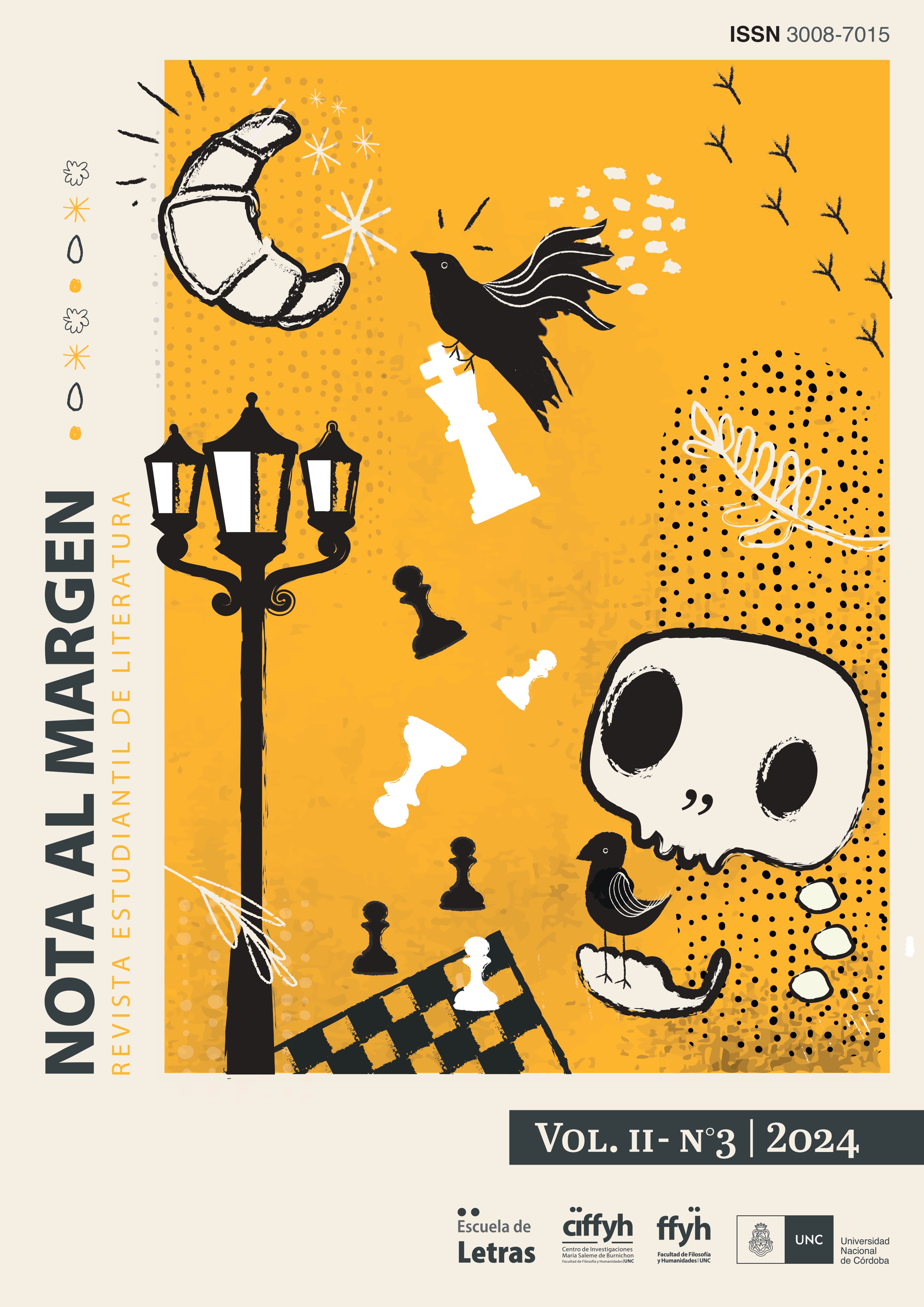Like a Shooting Star, the Suspended Trace of a Subject on the Run Storms. The Nomad Lyrical Subjectivity of Alejandra Pizarnik
Keywords:
Alejandra Pizarnik, argentine literature, lyrical subjectivity, nomadism, Karoline von GünderrodeAbstract
This article aims to analyze Alejandra Pizarnik’s poetic work to see how the lyric deconstructs the modern idea of identity, sustained in the uniqueness and homogeneity of the subject. In effect, the latter is presented in a fragmentary and discontinuous way, that is, it is in flight and permanent evolution. She sets out to demonstrate the configuration of a nomadic lyrical subjectivity: it is only identifiable at the moment when its temporary trace bursts into the poetic space. From this, in constellation with other metatextual materials, we analyze the poem “Caroline de Gunderode” (1959). Here, in dialogue with the tradition of German romanticism and surrealism, Pizarnik attributes a repertoire of masks to the suffering, romantic and suicidal poetess and presents the problem of lyrical subjectivity, revealing its character of fictional construction.
Downloads
References
Aira, C. (2001). Alejandra Pizarnik. Beatriz Viterbo.
Aronne-Amestoy, L. (1983). La palabra en Pizarnik o el miedo de Narciso. Inti: Revista de literatura hispánica, (18)15. https://digitalcommons.providence.edu/inti/vol1/iss18/15
Bermúdez-Cañete, F. y Trancón y Widemann, E. (1995). Introducción general al romanticismo. En F. Bermúdez-Cañete, E. Trancón y Widemann (Eds.), Antología de románticas alemanas (Trad. F. Bermúdez-Cañete, E. Trancón y Widemann). Cátedra.
Bascoy Lamelas, M. (2001). Karoline von Gunderrode: La deconstrucción de un mito. Universidad Santiago de Compostela. https://idus.us.es/bitstream/handle/11441/60544/BASCOY_Lamelas_Montserrat.pdf?sequence=1&isAllowed=y
Benveniste, É. (1997). De la subjetividad en el lenguaje. En Problemas de lingüística general I (Trad. Juana Almela). Siglo XXI Editores.
Blanchot, M. (2002). El Espacio Literario. Paidós.
Catelli, N. (1991). El Espacio Autobiográfico. Lumen.
Deleuze, G. (1990). ¿Qué es un dispositivo? En E. Balbier, Michel Foucault, filósofo. Gedisa Editorial.
Deleuze, G. y Guattari, F. (2008). Introducción: Rizoma. Mil Mesetas. Capitalismo y Esquizofrenia (pp. 9-32). Pre-textos.
De Man, P. (1991). La autobiografía como desfiguración (Trad. Ángel G. Loureiro). Suplementos Anthropos, (29), 113-117.
Derridá, J. (1995). Espectros de Marx. El Estado de la deuda, el trabajo del duelo y la nueva internacional (Trad. José Miguel Alarcón y Cristina de Peretti). Trotta.
Genette, G. (1989). Palimpsestos. La literatura en segundo grado. Taurus. (Trad. C. Fernández Prieto).
Guattari, F. y Rolnik, S. (2013). Micropolítica. Cartografías del deseo (Trad. Florencia Gómez). Tinta Limón.
Günderode, K. (1861). Correspondance of Fräulein Günderode and Bettine von Arnim. T. O. H. P. Burnham, 12-13.
Heidegger, M. (1944). Holderlin y La esencia de la poesía y Esencia del Fundamento. (Trad. J. D. García Bacca). Séneca.
Kristeva, J. (1981). La palabra, el diálogo y la novela. Semiótica I. (Trad. J. M. Arancibia). Fundamentos.
Lejeune, P. (1991). El pacto autobiográfico (Trad. Ángel G. Loureiro). Suplementos Anthropos, (29).
Loureiro, Á. G. (1991). La autobiografía y sus problemas teóricos. Suplementos Anthropos, (29).
Mallol, A. (1998). Una canción que sea menos que una canción: La constitución de la tradición literaria femenina en Olga Orozco, Alejandra Pizarnik, Susana Thénon y Diana Bellessi’. Tramas para leer la literatura argentina, (9), 152-161. Memoria Académica. http://www.memoria.fahce.unlp.edu.ar/art_revistas/pr.10960/pr.10960.pdf
Mignolo, W. (1982). La figura del poeta en la lírica de vanguardia. Semiosis, (9), 39-59.
Molloy, S. (2015). “Una torpe estatuilla de barro”: figuración de Alejandra Pizarnik. Taller de letras, (57), 71-79. ISSN 0716-0798.
Piña, C. y Venti, P. (2021). Biografía de un mito. Lumen.
Pizarnik, A. (2000). Poesía Completa (Ed. Ana Becciu). Lumen.
Pizarnik, A. (2001). Prosa Completa (Ed. Ana Becciu). Lumen.
Pizarnik, A. (2017). Nueva Correspondencia 1955-1972 (Eds. Ivonne Bordelois y Cristina Piña). Lumen.
Pizarnik, A. (2003). Diarios (Ed. Ana Becciu). Lumen.
Reisz de Rivarola, S. (1981). La posición de la lírica en la teoría de los géneros literarios. LEXIS, V(1), 73-86.
Straccali, E. y Crisorio, B. (2017). La poesía a través de los astros. En E. Straccali y Bruno Crisorio (Comp.), Atlas de la poesía argentina. Editorial de la Universidad Nacional de La Plata.
Rolnik, S. (2006). ¿El arte cura? Quaderns Portàtils, (2). MACBA. https://www.macba.cat/es/aprender-investigar/publicaciones/arte-cura
Published
How to Cite
Issue
Section
License
Copyright (c) 2024 Camila Victoria Esquivel

This work is licensed under a Creative Commons Attribution-NonCommercial 4.0 International License.
Usted es libre de:
Compartir — copiar y redistribuir el material en cualquier medio o formato.
Adaptar — remezclar, transformar y contruir a partir del material.
La licenciante no puede revocar estas libertades en tanto usted siga los términos de licencia
Bajo los siguientes términos:
Atribución — Usted debe dar crédito de manera adecuada,
brindar un enlace a la licencia, e indicar si se han realizado cambios.
NoComercial — Usted no puede hacer uso
del material con propósitos comerciales.









